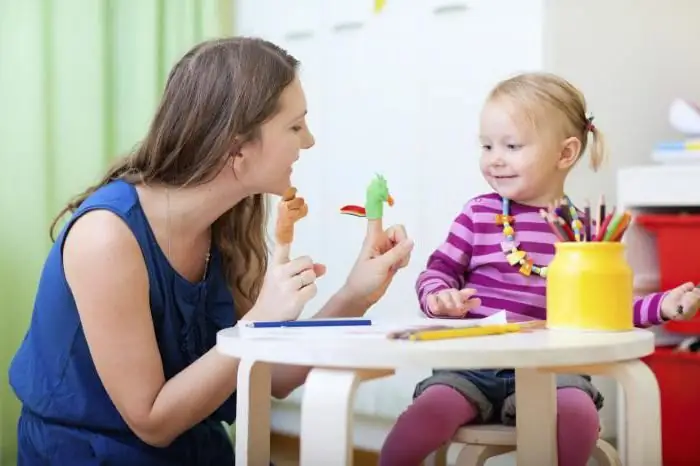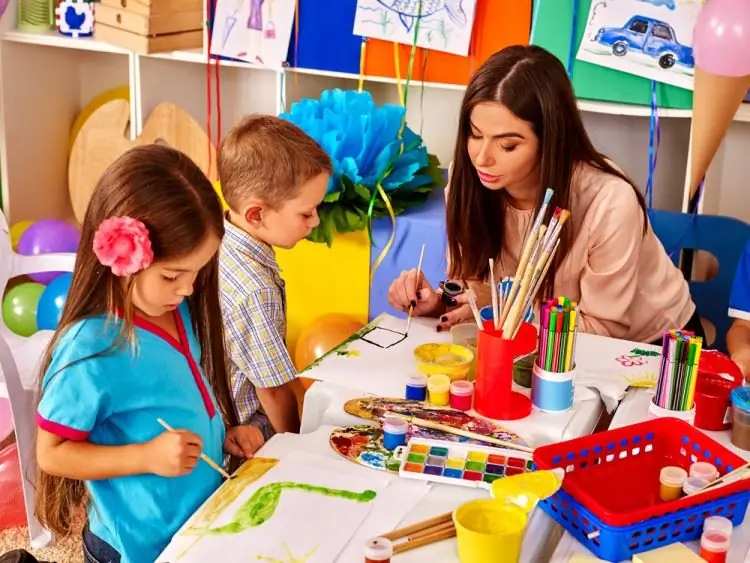2025 Author: Priscilla Miln | [email protected]. Last modified: 2025-01-22 17:55:13
Class in kindergarten is considered the main form of education for children, in which children learn new knowledge and reinforce what they have previously learned. The teacher, before conducting it, does a lot of preliminary work - prepares visual material, selects fiction, riddles or proverbs that can be used in order to attract the attention and interest of children. Also selects didactic games. This is very important, because children perceive new material using the senses.
Thinks out the topic of the lesson and the form of the lesson, how to organize the children so that everyone is in the teacher's field of vision, distribute each part of it in time so that the children do not get tired. This is done by changing activities. Even if the lesson is held at the tables, in the middle of it it is recommended to spend either a physical education minute or play an outdoor game.
In the article, we will consider the types of classes in the preschool educational institution, what forms of organization of children are used, how to attract children,so that they are happy to perceive new knowledge and at the same time do not consider classes to be hard work. We will also explain the purpose for which educators analyze their classes, what this form of work gives them. You will learn what parts the classes consist of, how the educational process differs in the younger and older groups of the kindergarten.
Varieties of activities
Types of classes in the preschool educational institution have several classifications. If we consider the solution of any didactic task, then we can distinguish 4 points. These are the following types:
- learning new material when the teacher explains to the children the topic planned according to the "Education Program", or new practical skills are being developed, for example, in modeling or drawing classes;
- consolidation of previously studied material - repetition of a poem, learned geometric shapes or numbers, retelling of a familiar fairy tale, didactic game "Name it right", etc.;

- classes in which children use the acquired knowledge and skills in the creative process, for example, come up with the end of a story, make an application according to a plan on a certain topic, come up with an addition or subtraction problem, complete a sentence, etc.;
- complex - this is a combination of different types of activities to master one task, for example, when studying the behavior of a squirrel, the teacher suggests guessing a riddle about the animal, looking at the picture, playing the game "What does the squirrel eat?", listen to a song about this animal, while thisthe teacher will tell about the habits of the forest jumper, how she prepares for the winter, give the children the task to count the number of nuts and mushrooms stored by the squirrel, and at the end will offer to draw the squirrel on their own according to the model of the teacher.
Knowledge content classification
More types of classes in the preschool educational institution can be divided according to the content of the knowledge gained. This can be a classic activity when the guys study the planned section of the program. It can be divided into several stages:
- explanation of new topic;
- reinforcing the material with questions on the topic or completing the task;
- summarizing the work.
Another type of organization of the educational process in kindergarten is called an integrated lesson. What is this type of occupation in preschool? Let's look at this in the following example. For example, the teacher raises the topic "Sea". The composition of sea water, transport that moves along the waves, who lives in the depths of the seas, what grows in the water, what covers the bottom, how people relax on the sea, what entertainments are on the water, etc. are discussed with the children.

The topics of classes in the preschool educational institution can be chosen as specific, for example, some natural phenomenon, a holiday or a hero of a fairy tale, as well as generalized - a store, a forest, a bakery. In the first option, children receive extended knowledge about something specific, and in the other, they form an understanding of a holistic picture of the operation of an enterprise or store, the life of a forest, etc.
Components of a classic lesson
The structure of the lesson in the preschool educational institution is divided into 3 mainparts, each of which has its own purpose.

- Preparation or organizational moment. The attention of preschool children is still hard to switch from one type of activity to another, so it takes time for the children to calm down, tune in to the lesson, concentrate on the teacher and what the teacher is talking about. This is achieved by a calm voice and the inclusion of a game moment, for example, a squirrel came to visit the kids and wants to tell a story that happened to her. At the same time, a bright toy appears in the hands of the teacher. It attracts the attention of children, they are already ready for the lesson material.
- The main part. If the initial stage lasts only a couple of minutes, then this component of the lesson is the longest, taking from 7 to 20 minutes, depending on the age group of the kindergarten. During this time, children receive new knowledge and consolidate them in practical activities or by completing the tasks of the teacher orally.
- The lesson ends with a summing up of the work, how they coped with the task, an analysis of children's work is carried out, if there was a visual activity. Be sure to note the active work of the children and tell what they will do next.
Excursions with children
Excursions are considered a special kind of group classes in preschool educational institutions. This may be an organized trip to the park or to the crossroads, to the store or to the river. The tour also has a clear structure. The first part is preparatory, which the teacher does independently. The place of the excursion is chosen, who will accompany the group of children, organizational issues are resolved.

The main part follows - a trip with children to the chosen place. During the tour, observation is carried out, children are asked questions, the chosen topic is discussed. The teacher uses verbal didactic games. You can organize the collection of natural material for further crafts.
After returning to the territory of the preschool institution, what they saw is fixed. It can be a simple conversation, an exchange of impressions or a display of what you see in drawings, making an album with a herbarium.
Public View
To improve the skills of conducting educational activities, one of the forms of work with teachers in kindergarten is open classes. They are held according to a schedule on certain days. The head teacher or methodologist, a group of educators from other groups can come to the lesson.

Regular working moments are reviewed to identify shortcomings in the teacher's work. After watching, they make an analysis of the lesson, discuss the methods and techniques of working with children, give advice and recommendations. This is a friendly visit that helps caregivers in their work, especially those who are just starting their careers.
Competitions in kindergartens
Yearly, they plan another form of open classes in preschool institutions - these are competitions between educators of a district or city. In this case, the preparation is more thorough, both for children andcaregivers.

If this is a music competition, then an interesting dance or song number is being prepared, if physical education is held, then the same uniform is purchased for children, an original plot is invented. For winning the competition, the teacher receives a diploma or a cash prize.
Preparing the teacher for the lesson
In order to conduct an interesting lesson for children, the teacher does a lot of preparatory work - selects visibility (pictures, photographs, slides or toys, models of fruits or theater figures), fiction (riddles, proverbs, sayings, poems or short stories), produces demonstration and handout material on a given topic.

Some activities require advance preparation, such as planting seeds and watching a sprout break through the soil. For a lesson in fine arts, you need to lay out sets of paints, brushes on the tables, pour water into cups, draw a sample or a schematic representation of an object. And how many details should be cut out before the application? This is a huge job that takes a lot of time in the evening before class.
Organizing children in class
Classes can be held with a whole group of pupils or subgroups. It is best to seat the children in such a way that their faces are turned towards the teacher. Foreign, distracting objects should not be present in children's hands.

In the course of the lesson, it is necessary to involve most of the children in active activities, constantly giving them tasks, asking questions. Be sure to alternate activities so that children do not get physically tired. From this, attention is scattered and the material will be learned poorly.
Self-analysis of the lesson in the preschool educational institution
This is a special form of work, an innovation that allows you to identify the effectiveness of the work done. Before the lesson, the teacher writes down on the sheet the questions that he plans to solve in the lesson, and after it he checks whether everything was done, whether the children learned the topic, how the guys behaved, were interested or distracted. The behavior of individual children is also analyzed, identifying passive or those with whom you need to work out individually.
As you can see, work in kindergarten is difficult, but creative and interesting. That is why educators are constantly improving their knowledge, inventing new forms of work with kids.
Recommended:
Lesson in the 2nd junior group on modeling: topics, abstracts of classes

Almost all children like to sculpt various plasticine figures. This process brings not only pleasure, but also positively affects the development of babies. In preschool institutions there is a specific modeling program. In this article, we will consider options for modeling classes in the 2nd junior group
Speech therapy classes for children (2-3 years old) at home. Speech therapist classes with children 2-3 years old

When a child at 2-3 years old does not speak, parents panic. It seems to them that if the neighboring children speak very well, then their baby is lagging behind in development. However, it is not. Speech therapists say that each child is individual. Non-speaking children can be taught at home. In this article, you can find exercises, tips and tricks that will help keep your child interested
Patriotic education of preschoolers according to GEF: lesson topics

Patriotic education of preschoolers according to GEF is quite relevant in today's conditions. This is due to the establishment of the priority of material values over spiritual ones in our society. However, the upbringing of the younger generation within the framework of respect and love for the Motherland forms a morally he althy, viable population
Gender education of preschool children. Gender aspect in the upbringing of preschool children

The article will talk about the gender education of preschool children. Identifies problems that arise and how to resolve them
Classes on the development of speech in the middle group. Analysis of the lesson on the development of speech

Classes on the development of speech in the middle group are held in order to form the correct speech skills in the child in accordance with the age category. The degree of adaptation among peers, as well as further education in primary school, depends on the correct pronunciation and the ability to express one's own thoughts

